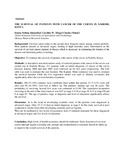| dc.contributor.author | Khaemba, Emma N | |
| dc.contributor.author | Mugo, Caroline W | |
| dc.contributor.author | Mutai, Charles | |
| dc.date.accessioned | 2013-11-29T07:00:56Z | |
| dc.date.available | 2013-11-29T07:00:56Z | |
| dc.date.issued | 2013-06 | |
| dc.identifier.citation | Khaemba, Emma N.,Mugo, Caroline W.,Mutai, Charles;June,2013.The Survival Of Patients With Cancer Of The Cervix In Nairobi, Kenya.Paper presented at the 2nd International Scientific Conference, Chs And Knh, 19th - 21st June 2013. | en |
| dc.identifier.uri | http://hdl.handle.net/11295/61057 | |
| dc.description.abstract | Background: Cervical cancer ranks as the second most frequent cancer among
women globally. Most patients present at advanced stages, leading to high mortality
rates. Information on the survival of cervical cancer patients in Kenya which is
necessary in estimating the burden of the disease and informing policy is lacking.
Objective: To estimate the survival of patients with cancer of the cervix in Nairobi,
Kenya
Methods: A descriptive non-intervention study of selected patients with cancer of
the cervix was carried out in Nairobi, Kenya. 211 patients with an initial diagnosis of
cancer of the cervix between January 2006 and June 2007 were followed up for five
years respectively. The Life table was used to estimate the cure fraction. The Kaplan-
Meier estimator was used to estimate the survival duration while the Cox regression
model was used to identify covariates that significantly affect the survival duration of
patients
Results: 108 (51.18%) patients were confirmed dead within that period, 15 (7.11%)
were still alive and 88 (41.70%) were lost to follow up. The patients’ median age was
46 years. The probability of surviving beyond five years was estimated at 0.198. The
cumulative proportion surviving at the end of the study interval was 0.67 at stage
I, 0.36 at stage II, 0.15 at stage III and 0 at stage IV. The age of patients, stage at
diagnosis and level of education significantly affects the survival.
Discussion: As is the trend in developing countries most of the patients were
diagnosed at advanced stages. Only 15 (7.11) had an initial diagnosis at stage I. In
this study survival is poor compared to results from other developing countries such
as Uganda.
This can be attributed to low levels of awareness, lack of standard treatment for those
diagnosed at advanced stages and low levels of education.
2 2nd Bi-ennual International Scientific Conference 2013, Nairobi Kenya
Conclusion: High levels of health awareness should be embraced. Early detection of
cervical cancer through regular screening and, prompt and comprehensive treatment
should be taken up to improve the overall survival of the patients. | en |
| dc.language.iso | en | en |
| dc.publisher | University of Nairobi | en |
| dc.title | The Survival Of Patients With Cancer Of The Cervix In Nairobi, Kenya | en |
| dc.type | Presentation | en |
| local.publisher | College of Health Sciences | en |

